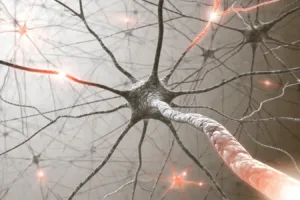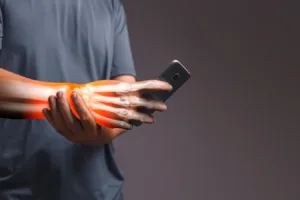
- What Is Nerve Entrapment?
- Common Nerve Entrapment Syndromes
- What Causes Nerve Entrapment?
- Diagnosis and Treatment
- When to Seek Medical Attention
- Frequently Asked Questions
Do your hands ever feel like they’re constantly “falling asleep”? Or maybe you experience shooting pains, numbness, or tingling? You might be dealing with nerve entrapment syndrome — a condition Coastal Orthopedics commonly treats across our Bradenton, West Bradenton, and Lakewood Ranch offices.
Carpal tunnel syndrome is the most common and best-studied nerve entrapment syndrome of the hand, affecting approximately 1 to 3 people per 1,000 each year and up to 50 per 1,000 in the general U.S. population. The incidence of nerve entrapment syndromes increases with age, and women are affected significantly more often than men, with a ratio of roughly 10 to 1.
While carpal tunnel syndrome is the most well-known, many other conditions involve compressed nerves. At Coastal Orthopedics, our board-certified hand and upper extremity specialists treat patients with nerve entrapment in the hands, wrists, elbows, and beyond. Here’s a closer look at nerve entrapment syndromes as a whole and how carpal tunnel compares to similar conditions.

What Is Nerve Entrapment?
Nerve entrapment occurs when a nerve is compressed or squeezed, disrupting its ability to transmit signals effectively. This can lead to a variety of symptoms, including:
- Numbness or tingling
- Pain, often radiating or shooting
- Muscle weakness
- “Pins and needles” sensation
- Feeling like the affected area is “falling asleep”
Common Nerve Entrapment Syndromes
While carpal tunnel syndrome affects the median nerve in the wrist, other nerves throughout the body can also become entrapped. Some common examples include:
- Cubital Tunnel Syndrome: This condition affects the ulnar nerve at the elbow, often causing numbness and tingling in the ring and little fingers.
- Tarsal Tunnel Syndrome: Similar to carpal tunnel but occurring in the ankle, tarsal tunnel syndrome affects the posterior tibial nerve, leading to foot pain and numbness.
- Peroneal Nerve Entrapment: Compression of the peroneal nerve near the knee can cause foot drop and difficulty lifting the foot.
- Thoracic Outlet Syndrome: This condition involves compression of nerves and blood vessels in the space between the collarbone and first rib, leading to pain, numbness, and weakness in the arm and hand.

What Causes Nerve Entrapment?
Several factors can contribute to nerve entrapment. Occupational factors play a significant role in the development of nerve entrapment syndromes. Activities and occupations that require a high degree of repetitive activity involving the hand or upper extremity are more commonly associated with these conditions.
Additionally, conditions that trigger a chronic inflammatory state, such as diabetes or hypothyroidism, are also frequently implicated in the development of nerve compression syndromes.
Some of the reasons that nerve entrapment can develop include:
- Repetitive motions: Jobs or activities that involve repeated hand or wrist movements can increase the risk of carpal tunnel syndrome and other entrapment syndromes.
- Prolonged pressure: Leaning on elbows or wrists for extended periods can compress nerves.
- Injury: Trauma or injury can lead to swelling and nerve compression.
- Underlying medical conditions: Conditions like diabetes, rheumatoid arthritis, and thyroid disorders can increase the risk of nerve entrapment.
- Anatomy: Some people may have naturally narrower spaces where nerves pass, making them more susceptible to entrapment.
Not all of these causes can be avoided, and most of them develop slowly over time. So how does that affect how these conditions are treated? In some cases, hand surgery is necessary to relieve the discomfort of nerve entrapment and related conditions, but non-surgical options are often available as well.

Diagnosis and Treatment
Diagnosing nerve entrapment often involves a physical examination, medical history review, and nerve conduction studies or electromyography (EMG) to assess nerve function. Treatment options vary depending on the specific condition and severity, but may include:
- Conservative measures: Rest, ice, compression, elevation (RICE), splinting, physical therapy, and medications like NSAIDs can help reduce inflammation and pain.
- Injections: Corticosteroid injections can help reduce inflammation around the nerve.
- Surgery: In severe cases, surgery may be necessary to relieve pressure on the nerve.
When to Seek Medical Attention for Nerve Entrapment
It’s important to seek medical attention if you experience persistent numbness, tingling, pain, or weakness, especially if it interferes with your daily activities. Early diagnosis and treatment can help prevent permanent nerve damage.
Frequently Asked Questions
What are the first signs of nerve entrapment?
Early signs often include numbness, tingling, or a “pins and needles” sensation in the affected area, commonly the hands, wrists, or elbows.
Can nerve entrapment heal on its own?
Mild cases may improve with rest, splinting, and physical therapy, but chronic compression often requires medical treatment to prevent permanent nerve damage.
What happens if nerve entrapment is left untreated?
Without treatment, prolonged nerve compression can lead to permanent weakness, muscle atrophy, or loss of sensation.
How is nerve entrapment diagnosed?
Your orthopedic specialist may perform a physical exam and order tests such as nerve conduction studies or EMG to pinpoint the site and severity of compression.
What treatments are available at Coastal Orthopedics?
Our specialists offer conservative treatments like splinting, therapy, and injections, as well as minimally invasive surgical decompression when needed.
Where can I get nerve entrapment treatment near me?
Coastal Orthopedics provides comprehensive nerve entrapment care in Bradenton, Lakewood Ranch, and surrounding Manatee County, with advanced diagnostic and treatment options available at all locations.
Do I need a referral to see a hand specialist?
In most cases, you do not need a referral — appointments can be scheduled directly online or by phone.
Relief from nerve pain starts with the right diagnosis. Schedule an appointment with one of our skilled hand specialists or our Physiatrist at Coastal Orthopedics and take the first step toward lasting comfort and restored mobility.




